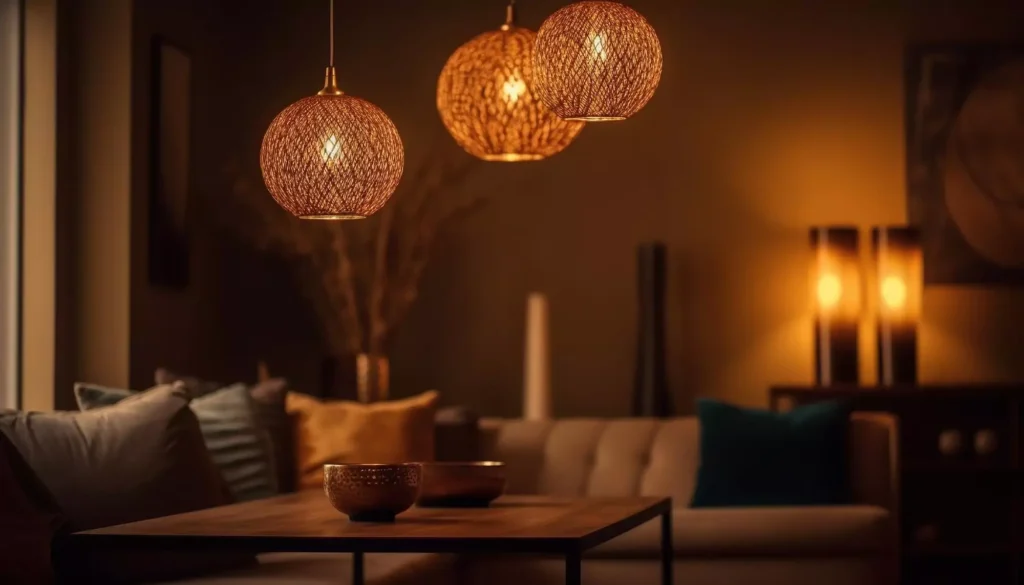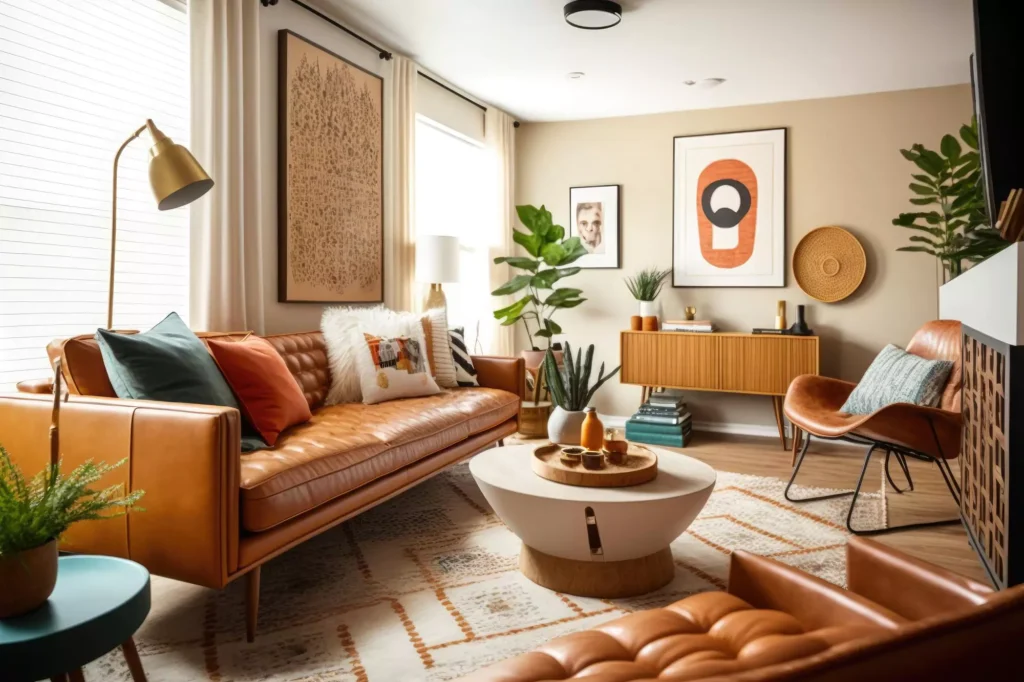Choosing the ideal lighting for each area in your house is often a fun task. Lighting is more than just removing shadows; it also sets the tone, fosters an ambience, and draws attention to the aesthetic appeal of your area.
So start looking for the best lighting for your home. Here, we’ll look at the intriguing diversity of options for house lighting. We’ll talk about how each area has different lighting requirements, and important things to think about, and even look at some eco-friendly and energy-efficient solutions. So let’s start this illuminating adventure if you’re ready to do so.
- 1. Understanding the Basics of Home Lighting
- 2. Factors to Consider When Choosing Lighting
- 3. Lighting for Different Rooms
- 4. Choosing the Right Bulbs and Fixtures
- 5. The Role of Dimmer Switches
- 6. Layering Lighting for a Well-Lit Room
- 7. Energy-efficient and Eco-Friendly Lighting
- 8. Lighting Design Tips and Tricks
- Wrapping Up
1. Understanding the Basics of Home Lighting
Alright, let’s start with the basics. When it comes to lighting your home, it’s not a one-size-fits-all scenario. We’re working with three main types of lighting: ambient, task, and accent. It’s like they’re the three musketeers of lighting, each playing a vital role in your home’s lighting scheme.
2. Factors to Consider When Choosing Lighting
Every room in your home is unique. The kitchen, the bedroom, the living room—they all have different personalities and purposes. To light them effectively, you need to consider a few essential factors:
1. Room Size and Layout: Think of your room as a puzzle. The size and layout dictate the puzzle pieces. Larger rooms may need multiple sources of ambient lighting to ensure even illumination. In smaller spaces, a single fixture might do the trick. Make sure you know your room’s measurements like the back of your hand.
2. Purpose of the Room: What’s the main gig in the room? Is it where you cook up a storm, or is it a cosy cocoon for Netflix nights? Understanding the primary function of a room helps you choose the right lighting. You wouldn’t put a disco ball in your kitchen, right?
3. Natural Light Availability: Mother Nature has its lighting scheme. Rooms that bask in natural light require less artificial illumination during the day. In contrast, spaces with limited access to sunlight may need more lighting love.
4. Personal Preferences: We all have our quirks and likes. Some folks prefer bright, well-lit spaces, while others cosy up to softer, warmer lighting. Your taste is like the cherry on top of your lighting design.
3. Lighting for Different Rooms
Let’s roll up our sleeves and get down to business. Lighting for various areas in your house is not a one-size-fits-all proposition. It’s similar to making a custom suit; each space has its measurements and preferences.
3.1 Living Room Lighting
Your living room is the heartbeat of your home. It’s where you unwind, entertain guests, and occasionally argue about what to watch on TV. Finding the right lighting balance here is essential.
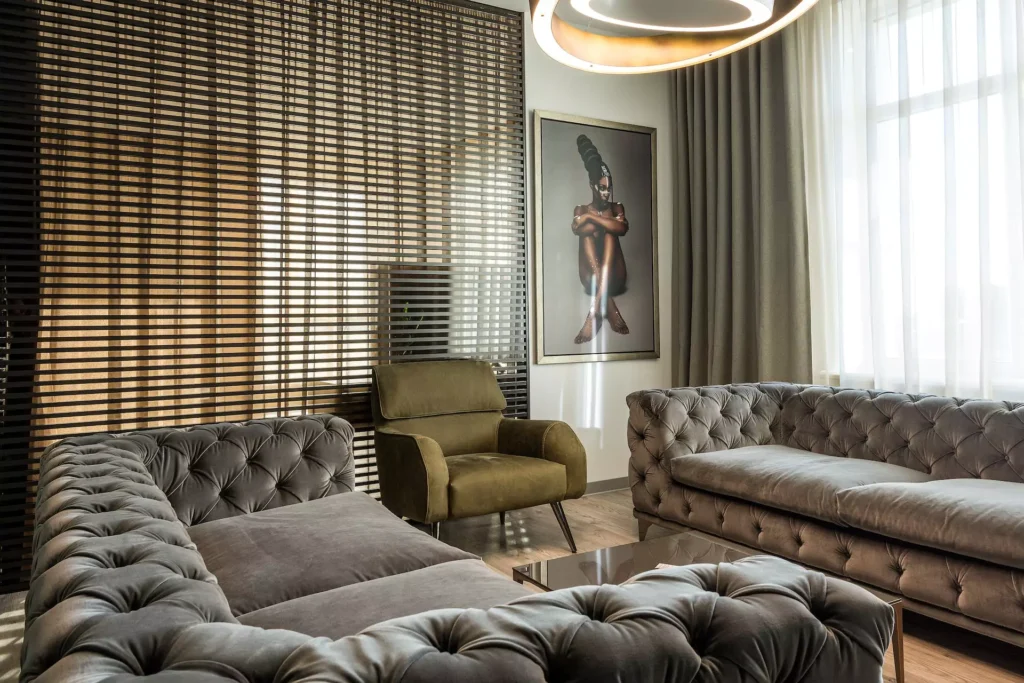

Key Considerations
- Flexibility: Your living room needs to be versatile. Look for adjustable lighting fixtures like floor lamps and table lamps that can change the mood from movie night to a reading marathon in a jiffy.
- Layering: Combine ambient, task, and accent lighting to create a welcoming and dynamic atmosphere. It’s like seasoning your favourite dish; the perfect blend makes all the difference.
- Dimmer Switches: They’re your best friend in the living room. Dimmers let you play with the room’s mood. So, whether you want cosy and intimate or bright and lively, dimmer switches are the magic wand.
1. Ambient Lighting: The backbone of your living room’s lighting. You might opt for a stylish chandelier, perhaps even a pendant light. The idea is to get even illumination that spreads love to every corner of your room.
2. Task Lighting: For those cosy corners where you read a good book or finish that crossword puzzle. You’re looking at floor lamps or table lamps that are your loyal companions for these activities.
3. Accent Lighting: This is where the magic happens. Wall sconces, spotlights, or even pendant lights are your paintbrushes. Use them to highlight that gorgeous piece of art, your collection of rare books, or your eccentric decor.
3.2 Kitchen Lighting
Ah, the kitchen—where you whip up culinary masterpieces or occasionally burn your toast. Task lighting is the superstar in the kitchen, but don’t forget about ambience.
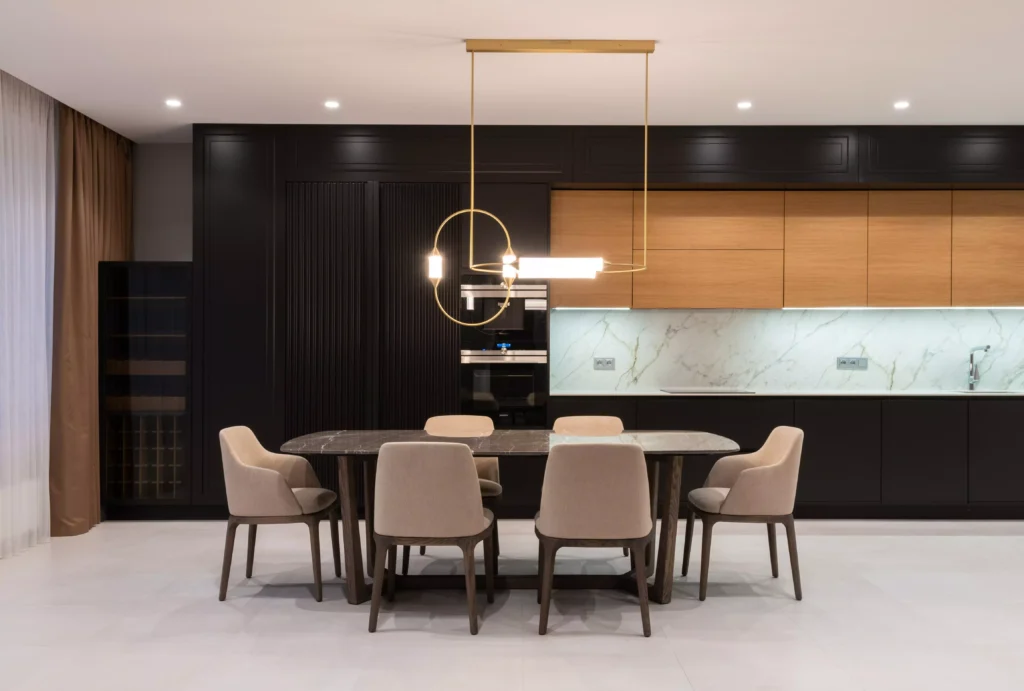

Key Considerations
- Task Lighting: Essential for slicing, dicing, and everything in between. Under-cabinet lighting and pendant lights over the kitchen island are your loyal sous-chefs.
- Bright and Cheery: Your kitchen needs to be well-lit, but not like a sterile hospital. Go for bright yet inviting overhead lighting. You want a space that feels as warm as a fresh loaf of bread.
1. Ambient Lighting: Your ceiling fixtures are the workhorses here. They provide overall illumination, making sure you can spot that rogue tomato trying to escape your chopping board.
2. Task Lighting: Under-cabinet lighting is your secret weapon. It’s like having your spotlight on the task at hand. Pendant lights over the island create a cosy cooking and dining space.
3. Accent Lighting: Use accent lighting to showcase your elegant kitchen decor or a cherished piece of china. It’s the culinary equivalent of a Michelin star.
3.3 Bedroom Lighting
Your bedroom is the sanctuary where you catch up on Zs, binge-watch your favourite shows, or cuddle up with a good book. It’s a multipurpose space, and your lighting should reflect that.
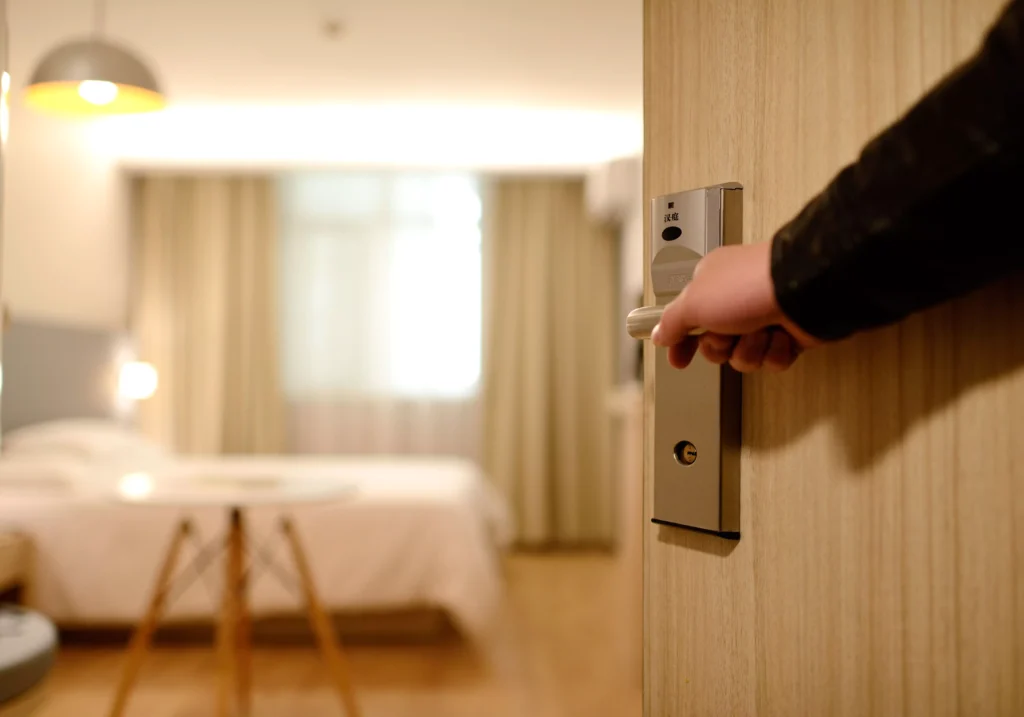

Key Considerations
- Balance is Key: Your bedroom needs a balance between ambient and task lighting. You want to read without disturbing your partner’s beauty sleep, right?
- Dimmer is Dreamy: A dimmer switch is like a lullaby for your room. It sets the perfect mood for relaxation, intimacy, or even yoga.
1. Ambient Lighting: The bedroom isn’t just for sleeping. You’ll need overall illumination. A chandelier or a stylish ceiling fixture sets the stage.
2. Task Lighting: Bedside lamps are your bedside companions. Opt for fixtures with adjustable arms and brightness settings. They’re perfect for bedtime reading or scrolling through your favourite blog.
3. Accent Lighting: Want to draw attention to your beautiful headboard or the artwork above your bed? Accent lighting can do wonders here. It adds that touch of magic to your room.
3.4 Bathroom Lighting
The bathroom is where you start your day, so it deserves some love. From your morning shave to your skincare routine, effective lighting is a game-changer.
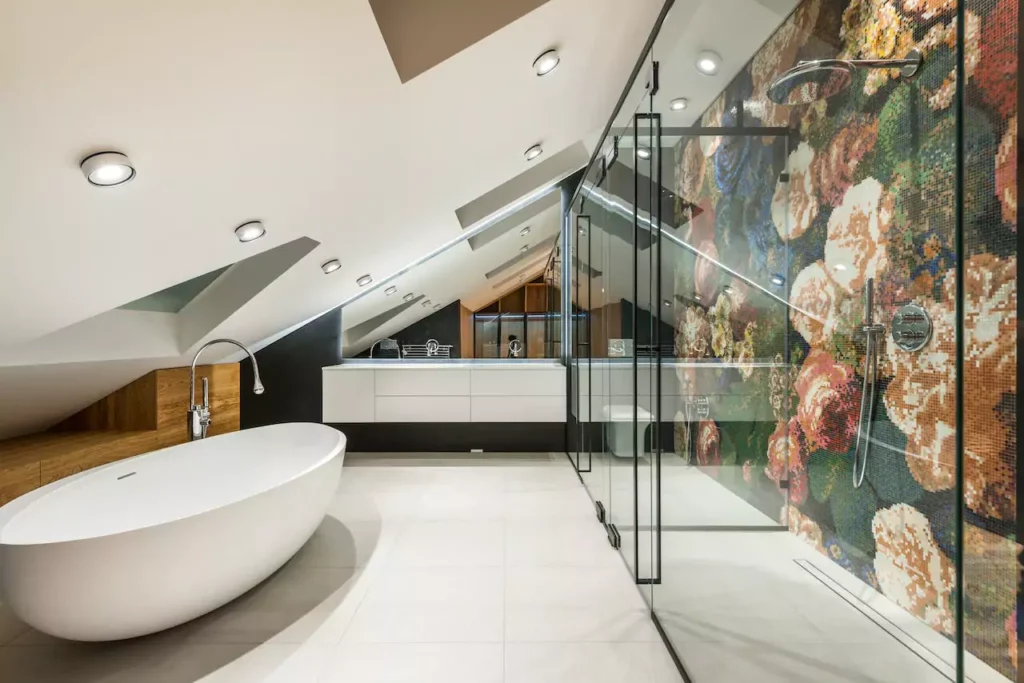

Key Considerations
- Mirror, Mirror: Your mirror is your confidante in the morning. Make sure it’s well-lit for grooming tasks. Task lighting on the sides is a must.
- No Shadows Allowed: Ensure even and shadow-free lighting. You don’t want to look like you’re auditioning for a vampire movie.
1. Ambient Lighting: Ceiling fixtures set the stage. You want overall illumination that’s crisp and clear, without harsh shadows.
2. Task Lighting: Vanity lighting is your secret to looking your best. Wall-mounted fixtures on either side of the mirror ensure you see every detail without distortion.
3. Accent Lighting: Want to show off the gorgeous tiles or a decorative niche in your bathroom? Accent lighting is the artist’s brush you need.
3.5 Dining Room Lighting
Dining rooms are all about creating a cosy and inviting atmosphere for sharing meals and making memories. The right lighting can set the stage for a memorable dining experience.
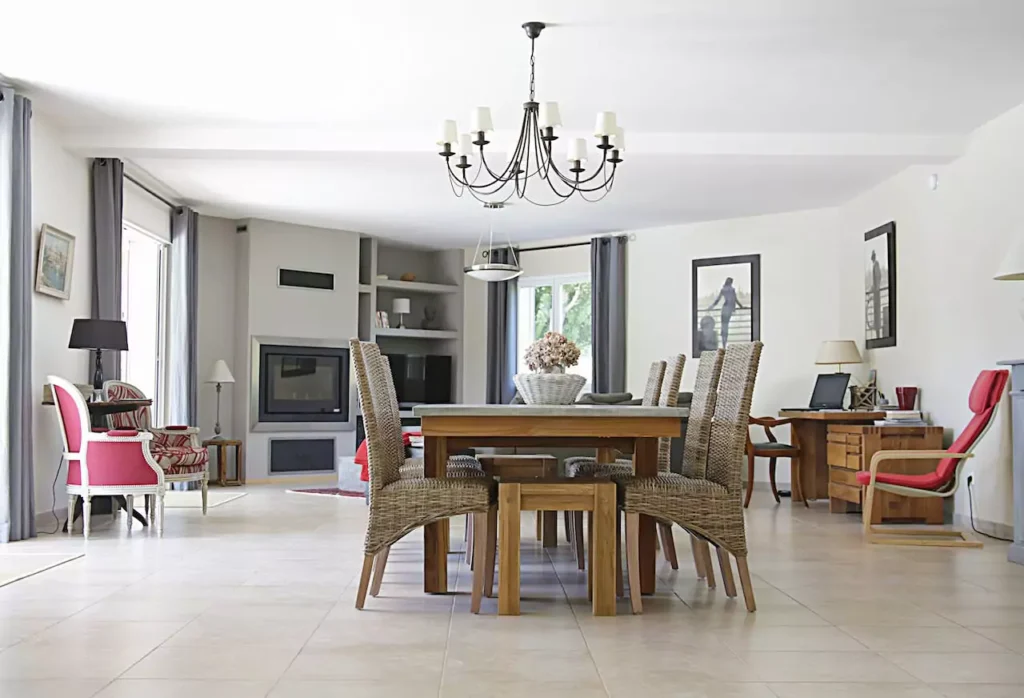

Key Considerations
- Create a Focal Point: Your dining table is the star of the show. A chandelier or pendant light can be your spotlight.
- Dim to Dine: Dimmable lights are your secret to setting the mood. Whether it’s a romantic dinner for two or a lively family gathering, dimmers give you control.
1. Ambient Lighting: A chandelier is a classic choice for dining rooms. It’s like the centre stage of your room, casting a warm glow that makes your guests feel like stars.
2. Task Lighting: The dining room isn’t usually a place for intense tasks, but some soft task lighting on your sideboard or bar area can add elegance to the space.
3. Accent Lighting: You can use accent lighting to highlight decorative elements like artwork, china cabinets, or your prized collection of fine wine. It adds a touch of sophistication.
3.6 Home Office Lighting
Your home office is the space where productivity and creativity collide. Effective lighting is your secret weapon for staying focused and comfortable.
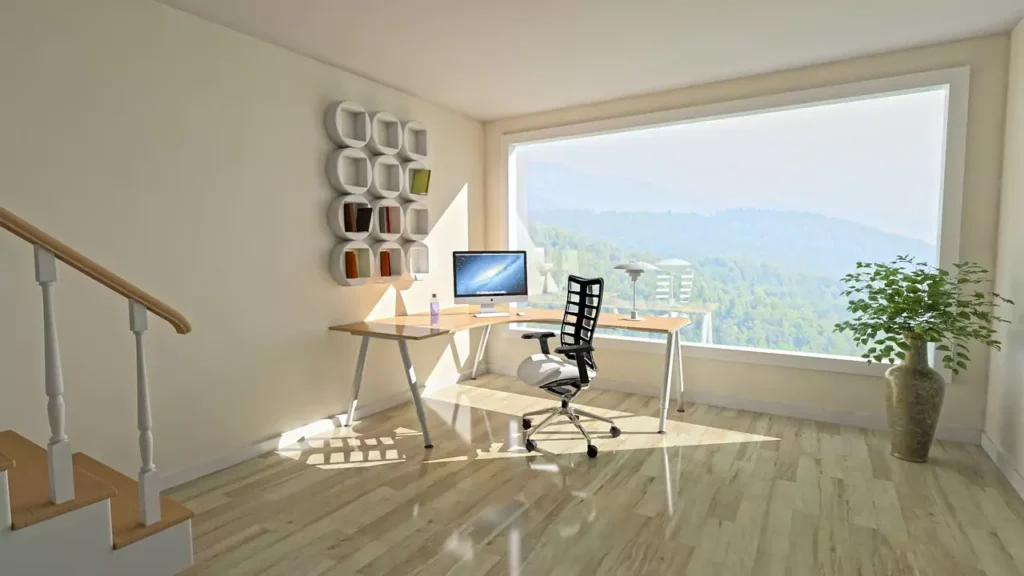

Key Considerations
- Well-Lit Workspace: You need plenty of light on your work surface. That means excellent task lighting to reduce eye strain.
- Be Flexible: Adjustable lighting fixtures are your co-workers. They ensure your lighting is just right for the task at hand, whether it’s a video call or a brainstorming session.
1. Ambient Lighting: Ceiling fixtures or track lighting provide overall illumination. They ensure your workspace is bright and welcoming.
2. Task Lighting: Desk lamps are your trusty companions. Look for fixtures with adjustable arms and brightness settings to customize your lighting.
3. Accent Lighting: Your home office may have decorative elements like artwork or open shelving. Accent lighting can help you show them off in style.
3.7 Hallway and Entryway Lighting
The hallway and entryway are the first impressions of your home. You want them to be welcoming and well-lit for guests and, of course, yourself.
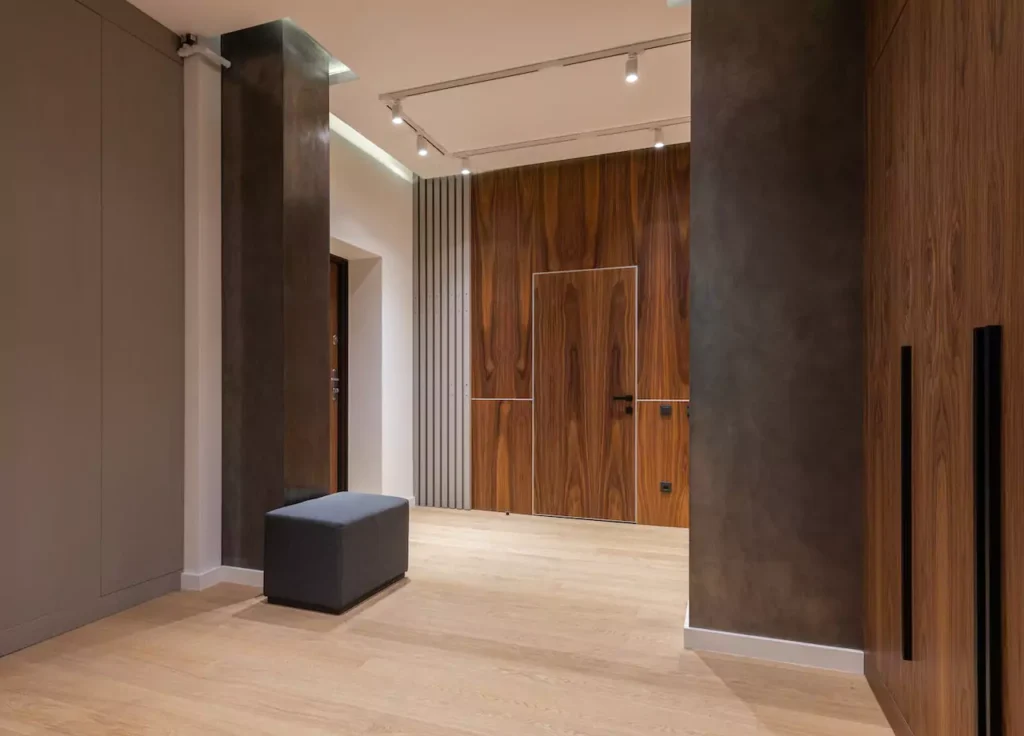

Key Considerations
- Safe Passage: Make sure your hallways are well-lit for safe passage. You don’t want to trip over a misplaced shoe or a rogue Lego.
- Welcome Mat: The entryway is your home’s first hello. It should be inviting and set the tone for what’s inside.
1. Ambient Lighting: Ceiling fixtures or wall sconces provide the necessary overall illumination for your hallways. They make sure there are no hidden surprises.
2. Task Lighting: Task lighting in hallways is minimal but can include wall-mounted fixtures or picture lights to highlight artwork or mirrors. Entryway tables with lamps serve a dual purpose—functional and decorative.
3. Accent Lighting: Use accent lighting to highlight architectural features like niches or mouldings. In the entryway, pendant lights or chandeliers can make a grand statement and set the stage for what’s inside.
4. Choosing the Right Bulbs and Fixtures
Now that we’ve discussed the various rooms, you might wonder about the nuts and bolts—bulbs and fixtures. They’re the actors on the stage of your lighting design. Each bulb and fixture has its role, and choosing the right ones is critical.
Bulbs are like the personalities of your lighting scheme. They come in various types, and each has its quirks:
- Incandescent Bulbs: Traditional, warm, and familiar, but not very energy-efficient.
- LED Bulbs: Highly efficient, long-lasting, and available in various colour temperatures.
- CFL Bulbs: Energy-efficient but take a moment to warm up, and they contain small amounts of mercury.
- Halogen Bulbs: Efficient and often used for task lighting.
- Smart Bulbs: Remote-controlled and customizable, they add a tech-savvy touch to your home.
- Fixtures are the supporting actors that bring the story to life. Here are some of the popular ones:
- Ceiling Fixtures: They provide ambient lighting. Chandeliers, pendant lights, and flush-mount fixtures are common choices.
- Wall Sconces: Versatile for both ambient and accent lighting. They come in various styles to match your decor.
- Floor Lamps: Excellent for adding both ambient and task lighting. They are portable and can be moved around as needed.
- Table Lamps: Ideal for task and accent lighting in living rooms, bedrooms, and home offices. They come in various sizes and designs.
- Recessed Lighting: Provides ambient or task lighting subtly. Commonly used in kitchens, hallways, and bathrooms.
- Track Lighting: Offers flexibility in directing light where needed. Suitable for both ambient and accent lighting.
5. The Role of Dimmer Switches
Okay, let’s talk about an unsung hero in your lighting design—the dimmer switch. Dimmer switches are like the conductors of your lighting orchestra. They give you the power to control the intensity of your lighting, allowing you to adjust it for different moods and occasions. Here’s how dimmer switches can elevate your lighting game:
- Mood Control: Dimmers are like your lighting maestro. You can create various atmospheres in a room, from a cosy movie night to a bright reading corner.
- Energy Efficiency: By lowering the lights, you save energy and extend the lifespan of your bulbs. Less power consumed, less frequent replacements needed.
- Reduced Glare: Dimming lights minimize glare on screens and reflective surfaces, making them more comfortable for your eyes.
- Longevity: Dimmed lights generate less heat, which can prolong the life of your bulbs. Fewer replacements, fewer headaches.
Installing dimmer switches is often a DIY project. However, if you’re not comfortable with electrical work, it’s a good idea to consult a professional electrician. The control and flexibility they provide are well worth the effort.
6. Layering Lighting for a Well-Lit Room
Now, picture your room as a canvas, and your lighting fixtures as the brushstrokes that bring it to life. Creating a well-lit room involves layering different types of lighting to achieve the right balance between functionality and aesthetics. It’s like creating a symphony, each instrument playing its part. Let’s break down the art of layering lighting:
- Start with Ambient Lighting: Begin with ambient lighting to establish the room’s general illumination. This can come from ceiling fixtures, chandeliers, or track lighting.
- Add Task Lighting: Depending on the room’s function, introduce task lighting to provide focused illumination where needed. Task lighting can include reading lamps, under-cabinet lighting, or desk lamps.
- Incorporate Accent Lighting: To create a visually appealing space, add accent lighting. This can include wall sconces, track lights, or even decorative pendant lights.
- Use Dimmer Switches: Install dimmer switches to give you precise control over the room’s brightness. Dimmers enable you to customize the lighting for various activities and moods.
Example: Layering Lighting in the Living Room
- Ambient Lighting: Having an elegant chandelier in the heart of the room that casts a warm, inviting glow. Recessed lights in the ceiling supplement the chandelier by providing even, ambient lighting.
- Task Lighting: Elegant floor lights near sitting areas provide ideal reading lighting. A table lamp on the side table provides additional task illumination.
- Accent Lighting: Wall sconces on either side of a decorative mirror provide accent lighting, creating a focal point in the room. Adjustable spotlights highlight the artwork on the walls.
- Dimmer Switches: Don’t forget the dimmers. They’re there for the chandelier, wall sconces, and recessed lights. With dimmer switches, you can adjust the room’s brightness for different activities, whether it’s movie night, reading, or entertaining guests.
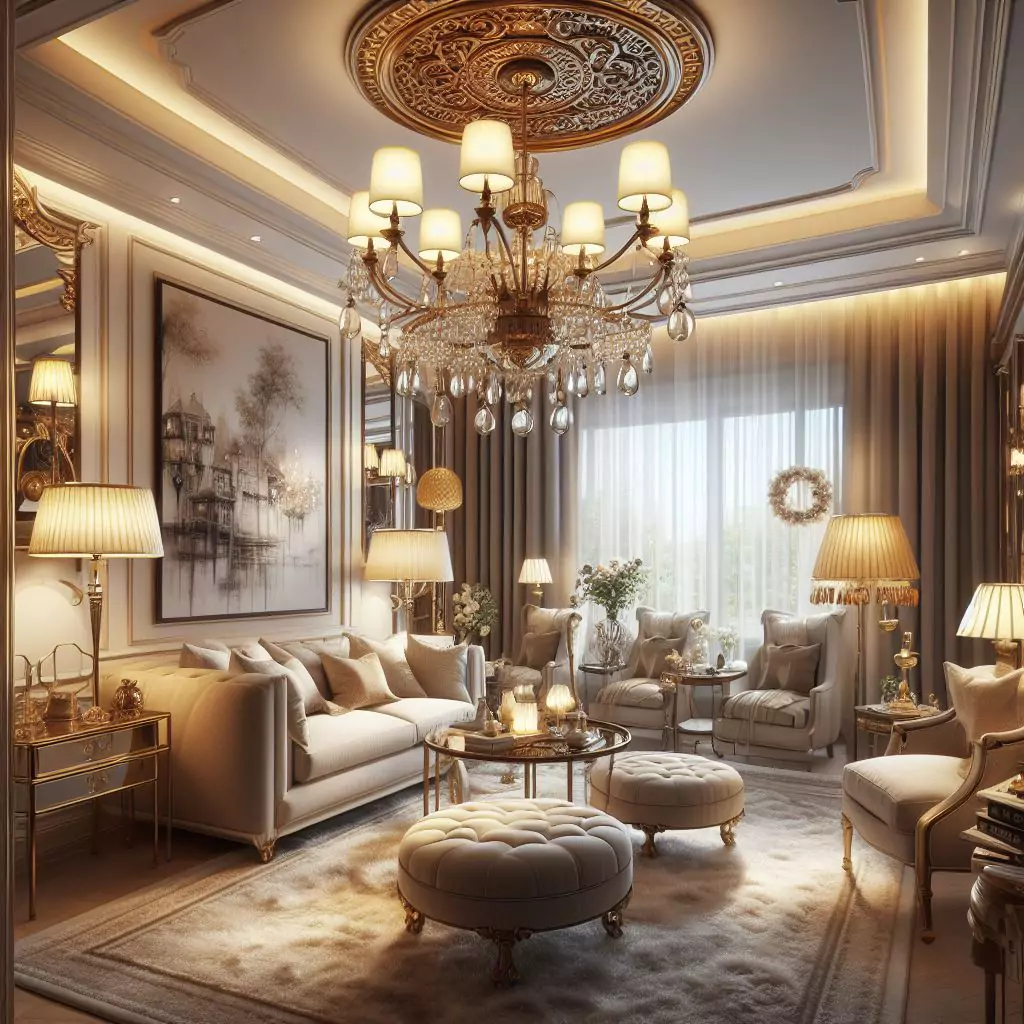

Layering lighting in this way adds depth and dimension to your room, making it visually engaging and functional. It’s the secret sauce to creating a well-lit masterpiece.
7. Energy-efficient and Eco-Friendly Lighting
In today’s world, energy efficiency and sustainability are top priorities. Not only does eco-friendly lighting reduce your carbon footprint, but it also saves you money on energy bills. Let’s talk about some energy-efficient and environmentally-conscious lighting options:
- LED Lighting: LED (Light Emitting Diode) bulbs are your eco-champion. They’re highly energy-efficient, durable, and come in various colour temperatures. They use significantly less energy than incandescent bulbs and produce minimal heat.
- CFL Bulbs: Compact Fluorescent Light bulbs are more energy-efficient than incandescent but less so than LEDs. They might take a moment to warm up and should be recycled properly due to their small mercury content.
- Halogen Bulbs: Halogen bulbs are a type of incandescent bulb with higher efficiency. They offer bright, focused light, often used in task lighting. Keep in mind that they can get hot, so handle them with care.
- Smart Lighting: Smart bulbs, like those from Philips Hue or LIFX, are your eco-friendly tech companions. They can be controlled remotely through smartphone apps or voice commands. Many smart bulbs are energy-efficient and offer features like customizable colours and dimming.
- Solar-Powered Lights: For your outdoor lighting needs, consider solar-powered fixtures. They harness energy from the sun during the day and illuminate your outdoor spaces at night. They are an eco-friendly and cost-effective solution.
By choosing energy-efficient and eco-friendly lighting, you’re not only reducing your environmental impact but also enjoying long-term savings on your energy bills. It’s a win-win situation for you and the planet.
8. Lighting Design Tips and Tricks
Alright, we’re almost at the finish line, but before we wrap up, here are some lighting design tips and tricks to add that extra sparkle to your home:
- Create Focal Points
Use accent lighting to draw attention to specific areas, objects, or architectural details. A well-placed spotlight can transform a corner into a cosy reading nook or highlight a piece of art.
- Avoid Glare
Glare can be uncomfortable and visually distracting. Position task lighting so it doesn’t cast harsh shadows or reflections on screens or glossy surfaces. Use shades or diffusers to soften the light.
- Select the Right Color Temperature
Different colour temperatures create different atmospheres. Warm, soft white light (2700-3000K) is cosy and inviting, while cool white light (4000-5000K) is crisp and energetic. Choose the colour temperature that suits the room’s purpose and mood.
- Use Layers of Light
Layering different types of lighting (ambient, task, and accent) provides flexibility and depth to your room’s illumination. It allows you to adapt the lighting to various activities and occasions.
- Scale Matters
Consider the scale of your lighting fixtures in the room. Oversized fixtures can overwhelm a small space, while undersized fixtures may look out of place in a larger room.
- Avoid Over-Lighting
More light is not always better. Overly bright lighting can create discomfort and harsh shadows. Aim for balanced lighting that suits the room’s function.
- Choose Fixture Styles Carefully
Lighting fixtures should complement your room’s style and decor. Whether you prefer traditional, modern, industrial, or vintage, select fixtures that enhance the room’s aesthetics.
- Think Vertically
Don’t limit your lighting to the horizontal plane. Wall-mounted fixtures, pendant lights, and recessed lights can provide vertical illumination, adding depth and visual interest to your space.
- Lighting in the Bedroom
In the bedroom, opt for fixtures with soft, warm lighting to create a calming ambience. Consider using lamps with shades that direct light downward and reduce glare.
- Use Mirrors Strategically
Mirrors can reflect and amplify light, making a room feel more spacious and well-lit. Position mirrors to bounce natural and artificial light around the room.
Wrapping Up
Lighting is more than simply an essential need; it is also an important component of interior design. You may illuminate your house in style by knowing the intricacies of ambient, task, and accent lighting, taking into account aspects such as room size, function, and your tastes, and selecting the correct bulbs and fixtures.
Remember that each area is distinct, and the lighting you choose should reflect its personality and function. The appropriate lighting can alter your living areas, whether you want a peaceful bedroom, a practical kitchen, or an exquisite dining room.
So, the next time you walk into a place, think about how the lighting affects your experience. You’ll not only notice but also feel the difference as your well-lit house transforms into a haven of comfort, productivity, and beauty.
But keep in mind that your lighting experience matters to you. Explore your options, try new things, and enjoy the process of renovating your house one light bulb at a time. Good luck with your lights!

